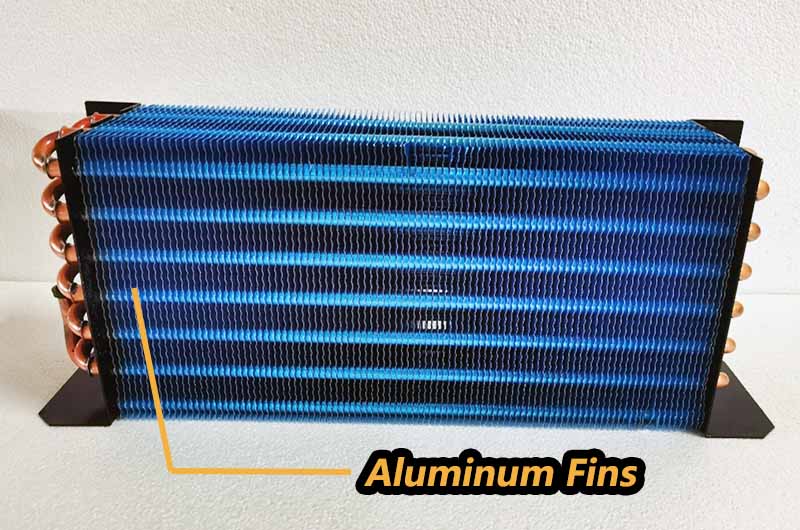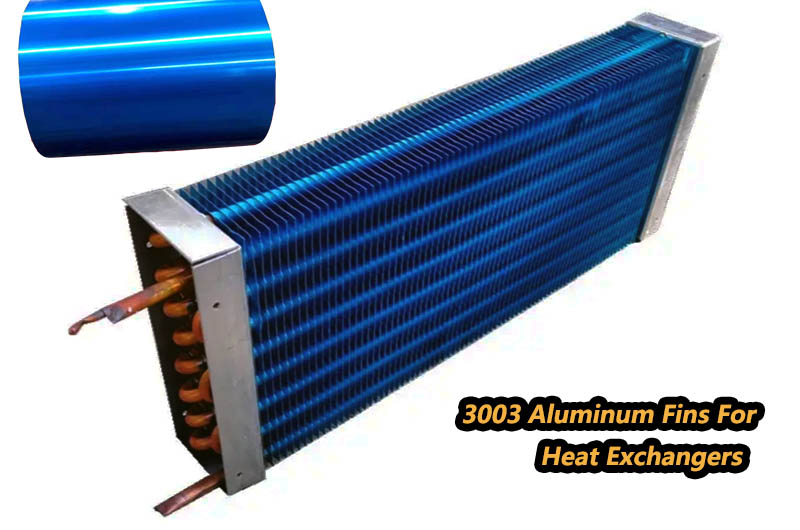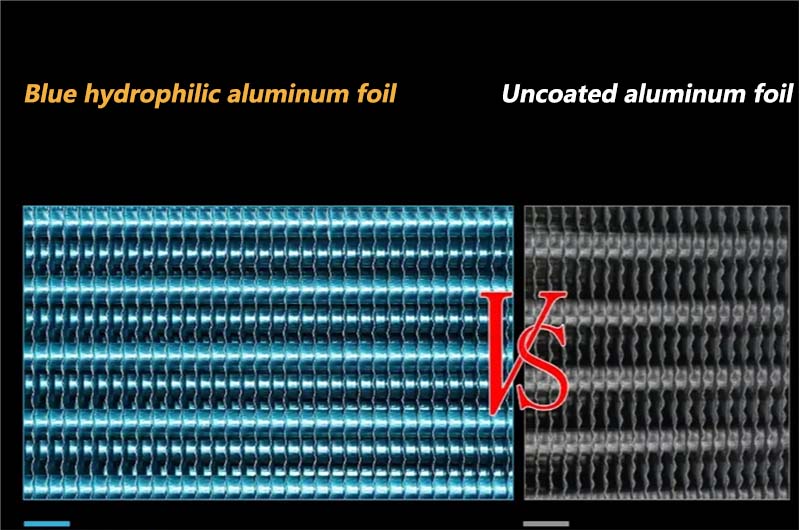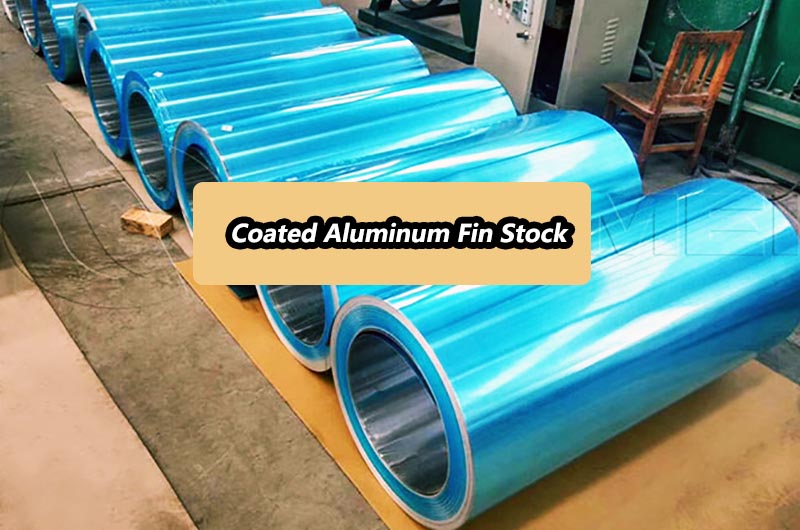- Understand the Heat Exchanger
- The Role of Aluminum Fins for Heat Exchangers
- Typical Aluminum Fins for Heat Exchangers
- The Significance of Coated Aluminum Fins for Heat Exchangers
- Coated Aluminum Fin Specifications
- Applications of Coated Aluminum Fins for Heat Exchangers
- Conclusion
Understand the Heat Exchanger
What are Heat Exchangers?
A heat exchanger is a device designed to transfer heat between two or more fluids or between a fluid and a solid surface.
What do Heat Exchangers do?
Their main purpose is to efficiently exchange thermal energy from one medium to another without mixing the two substances.
The working principle of heat exchanger:
- Heat Transfer: A heat exchanger facilitates heat transfer by bringing two fluids (or a fluid and a solid) close together without allowing them to mix.
- Temperature difference: Heat transfer occurs due to the temperature difference between two media, resulting in the transfer of thermal energy from a hotter substance to a cooler substance.

Common Heat Exchangers applications in daily life
Heat exchangers are everywhere, found in air conditioning systems, refrigeration units, power plants, and even the radiators of cars.
Heat Exchangers Types
- Shell and Tube Heat Exchanger
- Plate Heat Exchanger
- Double Pipe Heat Exchanger
- Finned Tube Heat Exchanger
- Adiabatic Wheel Heat Exchanger
- Plate-Fin Heat Exchanger
- Regenerative Heat Exchanger:
- Spiral Heat Exchanger
- Air-to-Air Heat Exchanger (Air Heat Recovery Unit)
- Plate and Shell Heat Exchanger
The Role of Aluminum Fins for Heat Exchangers
Aluminum is a popular choice for heat exchanger fins due to its excellent thermal conductivity, lightweight, and corrosion resistance.
The fins provide a larger heat exchange surface area, increasing the overall efficiency of the heat exchanger.
Typical Aluminum Fins for Heat Exchangers
1100 Aluminum Fins for Heat Exchangers
- Properties: Soft and ductile, with excellent formability and high thermal conductivity.
- Application: The fins of air conditioners are usually made of aluminum alloy 1100. The high thermal conductivity of 1100 aluminum alloy facilitates effective heat exchange, allowing the air conditioner to effectively cool the air.
3003 Aluminum Fins for Heat Exchangers
- Performance: Moderate strength, good formability, and high corrosion resistance.
- Application: Automotive radiator fins are usually made of aluminum alloy 3003. 3003 aluminum alloy has medium strength and corrosion resistance, making it suitable for different conditions in automotive cooling systems.

6061 Aluminum Fins for Heat Exchangers
- Performance: good strength, excellent corrosion resistance, good weldability.
- Application: Fins in automotive engine heat exchangers can be made of aluminum alloy 6061. Its good strength, excellent corrosion resistance and weldability make it suitable for the harsh conditions of vehicle engine compartments.
5052 Aluminum Fins for Heat Exchangers
- Performance: good strength, excellent corrosion resistance, high fatigue strength.
- Application: Heat exchanger fins in marine applications, such as ship cooling systems, can be made of aluminum alloy 5052. Its good strength, corrosion resistance and high fatigue strength make it suitable for marine environments.
8006 Aluminum Fins for Heat Exchangers
- Features: Specifically designed for heat exchanger fins, with high strength, good formability and corrosion resistance.
- Application: Fins in heat exchangers in automotive air conditioning systems can be made from aluminum alloy 8006. Designed specifically for this type of application, this alloy offers high strength, good formability and corrosion resistance, making it ideal for automotive HVAC systems.
Specifications for aluminum fins used in heat exchangers may include details such as thickness, width, temper and surface treatment. These specifications are typically based on the specific heat exchanger design and expected operating conditions.
However, advances in coating technology have taken aluminum fin performance to new heights.
The Significance of Coated Aluminum Fins for Heat Exchangers
A. Corrosion resistance
One of the main challenges with traditional aluminum fins is that they are susceptible to corrosion, especially in harsh environments. Coating the aluminum fins with a corrosion-resistant material can extend their service life, ensuring that the heat exchanger lasts longer.

B. Improved Heat Transfer
Advanced coatings applied to aluminum fins can significantly increase heat transfer efficiency. for example, nanotechnology-based coatings provide smoother surfaces, reduce friction and enable better heat conduction. This means an improvement in the overall performance of the heat exchanger.
C. Antifouling properties
Fouling, the accumulation of unwanted deposits on the surface of a heat exchanger, can have a negative impact on efficiency. Coated aluminum fins are anti-fouling, preventing the build-up of contaminants and ensuring stable heat transfer over the long term.
D. Adhesion
A well-adhered coating ensures fin durability under a variety of conditions, including thermal cycling and mechanical stress. This helps extend the life of the heat exchanger.
E.Temperature resistance
Coated aluminum fins are designed to withstand the temperature conditions of heat exchanger applications. This property is critical to maintaining performance and structural integrity in demanding environments.
F. Aesthetic considerations
Coatings can come in a variety of colors and finishes, allowing for customization based on aesthetic preferences. This is especially important for consumer-facing applications or industries where visual appeal is important.
G. Reduce maintenance requirements
The corrosion-resistant properties of coated aluminum fins reduce the need for frequent maintenance and replacement, thereby saving costs and increasing overall efficiency.
H. Application Versatility
Coated aluminum fins can be customized to meet the specific requirements of a variety of heat exchanger applications, including HVAC systems, automotive radiators, refrigeration units, and more.
I. Cost-Effectiveness
While the initial cost of coated aluminum fins may be higher than uncoated alternatives, the extended service life and reduced maintenance requirements often result in long-term cost savings.
J. Chemical resistance
Some coatings are resistant to a wide range of chemicals, protecting the fins from damage in applications where they may be exposed to corrosive substances.
K. Enhanced Manufacturing Options
Coatings can be applied using a variety of methods, providing flexibility in the manufacturing process and allowing the production of complex fin designs.
Coated Aluminum Fin Specifications
| Specification | Description |
|---|---|
| Aluminum Alloy | 1100, 3003, 6061, 5052, or application-specific alloys |
| Coating Type | Epoxy, Polyester, PVDF, or other specialized coatings |
| Coating Thickness | Specified in micrometers or millimeters |
| Corrosion Resistance | High resistance to environmental factors |
| Adhesion Strength | Strong bond between coating and aluminum surface |
| Color and Aesthetics | Varied colors and finishes for aesthetic considerations |
| Temperature Resistance | Ability to withstand heat exchanger temperature conditions |
Applications of Coated Aluminum Fins for Heat Exchangers
Coated aluminum fins find applications in various heat exchangers across different industries due to their enhanced performance, durability, and protection. Here are some specific applications:
1. HVAC Systems
Coated aluminum fins are commonly used in the fins of air conditioning and heating systems. The corrosion resistance and thermal efficiency of the coating contribute to the overall performance of HVAC units.
- Aluminum Alloy: Alloy 3003 or Alloy 1100 for good formability and thermal conductivity.
- Coating: Epoxy or polyester coatings for corrosion resistance.
- Thickness: Coating thickness in the range of 25 to 50 micrometers.
2. Automotive Radiators
Heat exchangers in automobile radiators often utilize coated aluminum fins. The corrosion resistance and temperature resistance properties are crucial in the demanding conditions of vehicle engine bays.
- Aluminum Alloy: Alloy 5052 or Alloy 3003 for a balance of strength and corrosion resistance.
- Coating: Zinc-rich epoxy or other coatings designed for automotive applications.
- Thickness: Coating thickness of 25 to 50 micrometers.

3. Refrigeration Units
In refrigeration systems, coated aluminum fins are employed to enhance the efficiency of heat transfer, contributing to the overall effectiveness of the cooling process.
- Aluminum Alloy: Alloy 1100 for high thermal conductivity.
- Coating: Polyester or PVDF coatings for corrosion resistance.
- Thickness: Coating thickness in the range of 20 to 50 micrometers.
4. Automotive Condensers
The condenser in a vehicle's air conditioning system uses coated aluminum fins to facilitate heat exchange, providing efficient cooling of the refrigerant.
- Aluminum Alloy: Alloy 3003 for its good formability.
- Coating: Hydrophilic coatings to enhance heat transfer efficiency.
- Thickness: Coating thickness of 15 to 30 micrometers.
5. Industrial Heat Exchangers
Various industrial processes rely on heat exchangers, and coated aluminum fins are applied in these systems to improve corrosion resistance and thermal performance.
- Aluminum Alloy: Alloy 6061 or Alloy 3003 for strength and corrosion resistance.
- Coating: Epoxy coatings for corrosion protection in industrial environments.
- Thickness: Coating thickness of 30 to 50 micrometers.
6. Oil Coolers
Heat exchangers used for cooling oils in engines and machinery often incorporate coated aluminum fins for their durability and resistance to corrosion in the presence of oil.
- Aluminum Alloy: Alloy 5052 for its strength and corrosion resistance.
- Coating: Epoxy or zinc-rich coatings suitable for contact with oils.
- Thickness: Coating thickness of 25 to 50 micrometers.
7. Process Industries
Coated aluminum fins are employed in heat exchangers within process industries such as chemical processing and petrochemical plants, where resistance to corrosive environments is crucial.
- Aluminum Alloy: Alloy 6061 or Alloy 8006 for strength and resistance to harsh conditions.
- Coating: Specialized coatings based on the specific chemical environment.
- Thickness: Coating thickness tailored to resist corrosive elements.
8. Power Plants
Heat exchangers in power plants, including those for cooling water in condensers or for transferring heat in various processes, may utilize coated aluminum fins for their thermal properties.
- Aluminum Alloy: Alloy 6061 for its strength and thermal conductivity.
- Coating: Polyester or epoxy coatings for general corrosion resistance.
- Thickness: Coating thickness of 30 to 50 micrometers.
9. Solar Water Heaters
Coated aluminum fins are suitable for use in solar water heaters, where they assist in the efficient transfer of solar energy to the water circulating in the system.
- Aluminum Alloy: Alloy 1100 for its high thermal conductivity.
- Coating: Selective coatings to enhance solar absorption.
- Thickness: Coating thickness of 10 to 25 micrometers.
10. Electronics Cooling
Coated aluminum fins are used in heat exchangers for electronics cooling, helping dissipate heat generated by electronic components in devices and systems.
- Aluminum Alloy: Alloy 6061 for its thermal conductivity.
- Coating: Thin coatings to maintain precise tolerances for electronic components.
- Thickness: Coating thickness in the range of 10 to 25 micrometers.
These applications demonstrate the versatility of coated aluminum fins in meeting the specific requirements of diverse heat exchanger environments, where the combination of corrosion resistance, thermal efficiency, and durability is critical. The choice of coating type and specifications may vary depending on the industry and the unique conditions of the application.
Conclusion
Coated aluminum fins have revolutionized heat exchangers, providing higher performance, longer service life and adaptability to different applications.
As technology continues to evolve, the combination of aluminum fins with advanced coatings promises greater efficiency and sustainability. Whether in your home’s HVAC system or at the heart of an industrial process, coated aluminum fins are quietly making a significant contribution to a more energy-efficient and environmentally friendly future.
